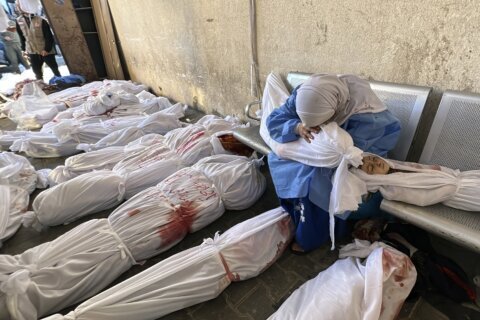Bradley Grigg, 46
Title: Chief behavioral health officer, Bartlett Regional Hospital
Location: Juneau, Alaska
Alaska was among states less affected by COVID-19 in terms of actual cases. However, in the remote capital city of Juneau, mental health problems spiked. Necessary pandemic precautions left its 33,000 residents more isolated than ever. Virtual learning kept students stranded at home with few social outlets.
Available mental health services were far outstripped by rising mental health needs, including increased suicide attempts. Grigg and his team strove to meet immediate demands for care and bring permanent improvements to the city’s mental health system of care.
As told to Lisa Esposito, as part of U.S. News & World Report’s “One Pandemic Question” series. Responses have been edited for length and clarity.
Q: How is the COVID-19 mental health crisis hurting families in your community?
We have patients that we have seen for years — we know them well, we love them, we care for them. But the amount of new folks my staff is seeing as a direct result of this behavioral crisis — it’s just unrelenting. There’s no slowdown.
Over the last year, we prepared for spikes of COVID-positive cases in our community. The surge that actually happened was the behavioral health crisis among kids and families.
For the first time, they’re experiencing heightened anxiety, depression and substance use as a result of ongoing COVID-19 mitigating health strategies. They’ve been facing distance schooling and loss of extracurricular activities, job losses and housing challenges.
[See: Coronavirus Prevention Steps That Do or Do Not Work. ]
Prior to March 2020, we had a behavioral health staff of about 115. Today we have over 150 full-time staff providing behavioral health supports alone in our small community hospital.
I’ve lived in Juneau 20 years and been with the hospital for four years. Typically, we would see four to six kids a month in the emergency room for mental health issues. Now, we’re seeing more than 20 kids a month. And that doesn’t include the continued spike we’re seeing in adults. We’re responding to the crisis — we’re not staying ahead of it yet.
We would historically get one to two kid a year who attempted suicide. From March to December 2020, we had 11 total suicide attempts, seven of which were among 14-year-old kids.
That’s when I started having a dialogue with community members, trying to get away from assumptions: what these kids look like, what kinds of home they come from, what kind of socioeconomic status they have. That’s when I talked about: They’re your neighbors, they’re your teacher’s kids, they go to church with you and they play sports with your kids.
We actually saw more folks come forward and say, ‘You know, I’ve been seeing some changes in my son, or my daughter.’ Most of the kids we’re seeing in the ER are not having a good academic year. Many are failing at least one course. And we saw hopelessness.
You have to find ways to connect your kids to activities to keep them moving and engaged socially. When those started to shut down and with schools going to distance learning, the chief complaints from kids were: I lost my identity. I’ve lost my friends. I’m failing in school.
[See: Fear, Courage, Grit: Meet More Than 50 ‘Hospital Heroes’ in Pictures.]
The Juneau terrain is breathtaking. The terrain is rough but there’s hiking, wildlife — amazing things to do here. But at the same time, your most beautiful piece is also your most challenging piece.
We’re surrounded on three sides by an icefield and the Canadian border. You can only get to Juneau by boat, ferry or plane. We do feel isolated just by living here. So, when you add the pandemic restrictions, it’s going to impact your community.
For years, we’ve only had outpatient care for mental health services in our community. So, unfortunately, when a child was experiencing an extreme psychiatric crisis, our default decision was to either send them to Anchorage, about 600 miles away, or Seattle, about 1,000 miles south. But that’s changing.
This week, we’re breaking ground on a 16,000-square-foot facility on campus that will house crisis stabilization units for kids, crisis stabilization units for adults, outpatient psychiatric treatment and an autism clinic. But the mental health crisis from the pandemic couldn’t wait.
Something had to be done. So about three months ago, we started a crisis intervention services team. After patients are treated and discharged from the ER, we then provide intensive observation and support where they live or even work for the next several days or week. We’ve already served over 40 families. We told them: Even though we don’t have the facilities yet — no worries. We’ll come to your home if you’ll invite us in. We’re going to commit to working with you to get you through this crisis and offer some next steps.
We’re seeing so much success in that these families are not coming back to us in crisis. Instead, they’re engaging in outpatient services after stabilization.
I can’t imagine sending either of my two kids 600 or 1,000 miles away for some kind of treatment. Now, parents are presented with an alternative. It’s one of the most fulfilling things in the world to keep a family intact in the moment of crisis.
More from U.S. News
What to Say to Friends or Family Members Who Hesitate to Wear a Mask
Ways to Boost Your Immune System
Personal Protective Equipment (PPE): Definition and Examples
Pandemic Intensifies Mental Health Pressures in Alaska Capital originally appeared on usnews.com







